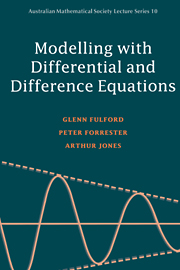Book contents
- Frontmatter
- Contents
- Preface
- Introduction to the student
- Part One Simple Models in Mechanics
- Part Two Models with Difference Equations
- Part Three Models with Differential Equations
- Part Four Further Mechanics
- Part Five Coupled Models
- 18 Models with linear interactions
- 19 Non-linear coupled models
- References
- Index
19 - Non-linear coupled models
Published online by Cambridge University Press: 05 June 2012
- Frontmatter
- Contents
- Preface
- Introduction to the student
- Part One Simple Models in Mechanics
- Part Two Models with Difference Equations
- Part Three Models with Differential Equations
- Part Four Further Mechanics
- Part Five Coupled Models
- 18 Models with linear interactions
- 19 Non-linear coupled models
- References
- Index
Summary
Further models of two interacting quantities are studied in this chapter. These models are distinguished from those of the previous chapter because they lead to coupled non-linear, rather than linear, differential equations. Such equations usually cannot be solved explicitly. Instead, a method of eliminating the independent variable, called the phase-plane technique, is developed for studying properties of the solution.
Non-linear equations often exhibit unusual or non-intuitive behaviour. A classic example considered in this chapter is the Lotka–Volterra equations which describe the interactions between predators and their prey. Applied to the study of fish and shark populations they predict that an increase in fishing will actually lead to an increase in the fish population.
In addition to the predator–prey system, models of combat and epidemics are presented.
Predator–prey interactions
Our concern in this chapter is with models which lead to coupled nonlinear differential equations. In this section it will be shown how a model describing the interaction of a predator (shark) and its prey (fish) leads to coupled non-linear differential equations for the shark and fish populations as functions of time.
Some unusual data
The Italian mathematician Vito Volterra (1860–1940) developed a model of predator–prey interaction in response to some unusual data. Extensive records had been kept of the yearly catches of fish and sharks at an Italian sea port (Fiume, 1914–1923). Table 19.1.1 shows the percentage ratio of sharks to total catch.
- Type
- Chapter
- Information
- Modelling with Differential and Difference Equations , pp. 379 - 398Publisher: Cambridge University PressPrint publication year: 1997

